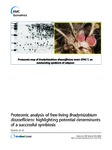Por favor, use este identificador para citar o enlazar este ítem:
http://www.alice.cnptia.embrapa.br/alice/handle/doc/993458Registro completo de metadatos
| Campo DC | Valor | Lengua/Idioma |
|---|---|---|
| dc.contributor.author | GOMES, D. F. | pt_BR |
| dc.contributor.author | BATISTA, J. S. da S. | pt_BR |
| dc.contributor.author | ROLLA, A. A. P. | pt_BR |
| dc.contributor.author | SILVA, L. P. da | pt_BR |
| dc.contributor.author | BLOCH, C. | pt_BR |
| dc.contributor.author | GALLI-TARASAWA, L. V. | pt_BR |
| dc.contributor.author | HUNGRIA, M. | pt_BR |
| dc.date.accessioned | 2017-06-19T23:53:09Z | - |
| dc.date.available | 2017-06-19T23:53:09Z | - |
| dc.date.created | 2014-08-26 | pt_BR |
| dc.date.issued | 2014 | pt_BR |
| dc.identifier.citation | BMC Genomics, v. 15, n. 643, 2014. | pt_BR |
| dc.identifier.uri | http://www.alice.cnptia.embrapa.br/alice/handle/doc/993458 | pt_BR |
| dc.description | Strain CPAC 7 (=SEMIA 5080) was recently reclassified into the new species Bradyrhizobium diazoefficiens; due to its outstanding efficiency in fixing nitrogen, it has been used in commercial inoculants for application to crops of soybean [Glycine max (L.) Merr.] in Brazil and other South American countries. Although the efficiency of B. diazoefficiens inoculant strains is well recognized, few data on their protein expression are available. We provided a two-dimensional proteomic reference map of CPAC 7 obtained under free-living conditions, with the successful identification of 115 spots, representing 95 different proteins. The results highlighted the expression of molecular determinants potentially related to symbiosis establishment (e.g. inositol monophosphatase, IMPase), fixation of atmospheric nitrogen (N 2) (e.g. NifH) and defenses against stresses (e.g. chaperones). By using bioinformatic tools, it was possible to attribute probable functions to ten hypothetical proteins. For another ten proteins classified as? NO related COG? group, we analyzed by RT-qPCR the relative expression of their coding-genes in response to the nodulation-gene inducer genistein. Six of these genes were up-regulated, including blr0227, which may be related to polyhydroxybutyrate (PHB) biosynthesis and competitiveness for nodulation. The proteomic map contributed to the identification of several proteins of B. diazoefficiens under free-living conditions and our approach? combining bioinformatics and gene-expression assays ? resulted in new information about unknown genes that might play important roles in the establishment of the symbiosis with soybean. | pt_BR |
| dc.language.iso | por | pt_BR |
| dc.rights | openAccess | pt_BR |
| dc.subject | Two-dimensional proteomics | pt_BR |
| dc.subject | RT-qPCR | pt_BR |
| dc.title | Proteomic analysis of free-living Bradyrhizobium diazoefficiens: highlighting potential determinants of a successful symbiosis. | pt_BR |
| dc.type | Artigo de periódico | pt_BR |
| dc.date.updated | 2017-06-19T23:53:09Z | pt_BR |
| dc.subject.nalthesaurus | Bradyrhizobium | pt_BR |
| dc.subject.nalthesaurus | nitrogen fixation | pt_BR |
| dc.subject.nalthesaurus | symbiosis | pt_BR |
| riaa.ainfo.id | 993458 | pt_BR |
| riaa.ainfo.lastupdate | 2017-06-19 | pt_BR |
| dc.identifier.doi | 10.1186/1471-2164-15-643 | pt_BR |
| dc.contributor.institution | DOUGLAS FABIANO GOMES, Departamento de Génetica UFPR; JESSIANE STEFÂNIA DA SILVA BATISTA, DEBIOGEM UEPG; AMANDA ALVES PAIVA ROLLA; LUCIANO PAULINO DA SILVA, CENARGEN; CARLOS BLOCH JUNIOR, Cenargen; LYGIA VITORIA GALLI TERASAWA, Departamento de Génetica UFPR; MARIANGELA HUNGRIA DA CUNHA, CNPSO. | pt_BR |
| Aparece en las colecciones: | Artigo em periódico indexado (CNPSO)  | |
Ficheros en este ítem:
| Fichero | Descripción | Tamaño | Formato | |
|---|---|---|---|---|
| 128642014Article6775.pdf | 3,06 MB | Adobe PDF |  Visualizar/Abrir |









